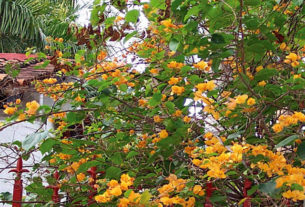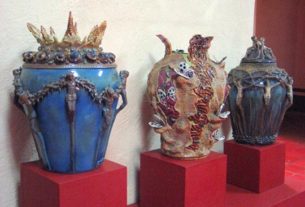Amid the reconstructed pyramids of Monte Alban, a pageant is performed commemorating ancient legends of how the sun and the moon and the Earth were born, and were set free to roam the heavens. Designed with help from the Dragon Theater of Maine, and performed by local singers, dancers and musicians, “Sol y Luna” will, hopefully, become an annual event.
“Curar”: to cure; thus Curandera(o): one who cures. Curanderas are “white witches”: practitioners of a medical system older than Hippocrates and as new as megavitamins and herbal teas sold at Safeway or Cub Foods. Many Mexicans (and others) believe that curanderas are at least as good as medical doctors, and it is not unusual for someone to consult both.
Last month, a new friend E-mailed me from the States, looking for a curandera. My friend, who suffers from a chronic, painful, but not fatal ailment, works as a health care provider. Because of her own combination of fear (am I going to be in the hands of a charlatan, or a “black” witch?) and skepticism (how can this be real?), she wanted to interview her practitioner before turning herself over for treatment. Her search piqued my interest, and I agreed to help.
Before you can use a curandera, you have to find her. Curanderas don’t hang out their shingle, especially not in a Catholic country, where claiming to have “powers” comes fairly close to heresy. Nonetheless, they are not hard to find. I asked my friend Yolanda, a bilingual Mixtec woman from a nearby village, to find me a curandera of high reputation. She immediately came up with three, in her village alone.
Her first choice was an “anciana” (old one); a woman with so extensive a reputation that people come to her from as far away as San Francisco, California. Her office hours are from noon until eight at night, and no-one may join the queue after 4 pm. Her business is so brisk that her husband acts as her business manager, controlling all aspects of her practice outside the consultorio. Although it had been set up for weeks, hubby decided at the last minute that while a treatment would be ok, an interview would not.
Second choice was a woman who had been practicing for “only” forty years, with a reputation that at this point extends only to Mexico City. She has no office hours, treating people as they come to her. Her husband is a farmer and leaves her business to her. It was to their house that Yolanda led us one February morning.
“Maria” (not her name) lives with her husband and children in a cement and adobe structure, on a side street in a small village not far from Oaxaca. The street is barely graded, and unpaved. There are at least eight dogs playing in the yard, along with three children. The consultorio is at the far end of a row of rooms along one side of the structure. When we arrive, the room is full of smoke from burning incense. One wall is decorated from floor to ceiling with images from the Catholic religion, tending toward illustrations of the Virgin Mary and the bleeding heart of Jesus. On the table (altar?) set against this wall are figurines and reliquaries. Some appear to represent deities more ancient than those brought by the Spanish. There is a table and two chairs for patient and curandera, and a bench for guests.
Maria is in her forties, plump, sparkle-eyed, relaxed. Like almost all village people I have encountered, she is open, generous and without guile. She answers our questions like she has done this thousands of times, yet she probably has never been interviewed before. She tells us she manifested her gift from earliest childhood, when her mother saw “a light” in her bedroom, which no-one else in the family could see (her great grandmother was said to have the gift, her grandmother not at all, and her mother only this small insight). She does not remember when she performed her first healing, but her mother told her she was around 6 years old. Her father disapproved of her gift, and warned her that people would think she was crazy and would be afraid of her. She understands now that he was just expressing his own fears, which ended when she cured him of cancer last year.
As we interview Maria, I keep an eye on my friend. Her body language is changing: from sitting back with her legs together and her hands folded in her lap, she is leaning forward, arms open, barely perched on the bench. There is a yearning in her eyes. She is ready to be cleansed. If it wasn’t for my own curiosity, the interview would have been terminated much sooner (more of Maria’s story another time).
My friend asks Maria if she will cleanse her (“limpia”, a cleaning, is the traditional word for the healing process, the theory being that sickness comes from a “bad wind” that enters the body and must be cleaned out). Maria agrees and asks me and Yolanda to leave. We go out to the courtyard, where Maria’s husband is shucking corn for tortillas, and chat about the weather.
About twenty minutes later, my friend emerges. She tells us that “something” took place which she can’t explain, but it left her feeling “giddy”. She is to return the next day. Yolanda agrees to accompany her. We part company, each to his or her own concerns. Through happenstance and error, my friend does not return to complete her treatments. I am allowed, therefore, to retire from the experience with my skepticism intact.



Hi is there any way you can give me the information to these two curanderas?
Sorry, Lisa, but we’re unable to help. The article was written twenty years ago and the author is no longer around to ask. However, if you’re in Oaxaca, then someone will likely know if you ask around. Good luck, TB.